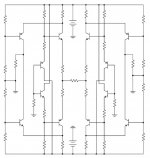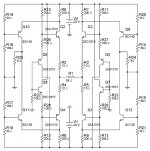Another one but totally NFB free, it comes from the other site, with the help of members and specially John.
As always, comments, hints and questions are welcome.
Fets 2SK170/2SJ74.
BJT's 2SA1145/2SC2705.
As always, comments, hints and questions are welcome.
Fets 2SK170/2SJ74.
BJT's 2SA1145/2SC2705.
An externally hosted image should be here but it was not working when we last tested it.
Allo Justcallmedad,
This is my first post in this forum.
Just a noobie's question : why doubling the constant current?
Je vous remercie.
This is my first post in this forum.
Just a noobie's question : why doubling the constant current?
Je vous remercie.
Justcallmedad said:Another one but totally NFB free, it comes from the other site, with the help of members and specially John.
As always, comments, hints and questions are welcome.
Fets 2SK170/2SJ74.
BJT's 2SA1145/2SC2705.
An externally hosted image should be here but it was not working when we last tested it.
A very remote cousin of the BT? 😎
Sorry, I mean current mirror Q1/Q2 - Q12/Q13.
After closed look, I may be understand : Q1/Q2 are current mirror and Q13 is VAS, cascoded by Q16.
Nice, I have to try it.
Salut.
After closed look, I may be understand : Q1/Q2 are current mirror and Q13 is VAS, cascoded by Q16.
Nice, I have to try it.
Salut.
toquito5000 said:Sorry, I mean current mirror Q1/Q2 - Q12/Q13.
After closed look, I may be understand : Q1/Q2 are current mirror and Q13 is VAS, cascoded by Q16.
Nice, I have to try it.
Salut.
It’s rather a cascoded Widlar current mirror, gain is only provided by the input fet’s.
You may try it, but from my point of view this is a bit strange mix of CFB based amp and BT output cascode.
A strange mix? - seems like something worth trying or even better comparing if someone has the components and the time!
Bill
Bill
Hi.
The idea is simple, just replacing complementary jfet with bjt-diamond.
Sure, I'll find the time to build and compare it with other, just for curiosity.
But first, I have to find the appropriate transistor and resistor value.
This is actually hard for me.
I do speaker and acoustic design but not really into amp design.
Build some DIY amp and preamp, but never design.
I tried to play a simulator and find something like this.
These are not optimum values, I know. Someone else will do much better than me for sure.
Question : Is it normal in this topology that odd harmonics dominate? Have it any important?
So please comment.
Thanks in advance. 😕 😕
😕 😕
The idea is simple, just replacing complementary jfet with bjt-diamond.
Sure, I'll find the time to build and compare it with other, just for curiosity.
But first, I have to find the appropriate transistor and resistor value.
This is actually hard for me.
I do speaker and acoustic design but not really into amp design.
Build some DIY amp and preamp, but never design.
I tried to play a simulator and find something like this.
These are not optimum values, I know. Someone else will do much better than me for sure.
Question : Is it normal in this topology that odd harmonics dominate? Have it any important?
So please comment.
Thanks in advance.
 😕 😕
😕 😕Attachments
Just to add, I like the diamond buffer structure. And I also like the complete current feedback structure, rather than standard differential VFB input.
But I do not see the reason for high impedance line output.
But I do not see the reason for high impedance line output.
Hi PMA,
Thanks for the comment.
Another diamond-buffer after folded cascode will do ?
Like you do in your dispre?
Thanks for the comment.
Another diamond-buffer after folded cascode will do ?
Like you do in your dispre?
Dispre is much simpler circuit, so it was easy to couple output diamond buffer (which I like a lot). I also did not solve DC, and used output capacitor, which is quite bulky and should be polypropylene.
PMA said:Just to add, I like the diamond buffer structure. And I also like the complete current feedback structure, rather than standard differential VFB input.
Sorry Pavel, I thought that you spoke global feedback.
[
- Status
- Not open for further replies.
- Home
- Amplifiers
- Solid State
- John Curl's Blowtorch preamplifier


